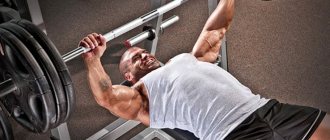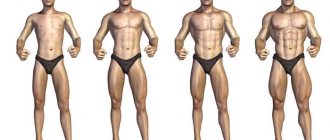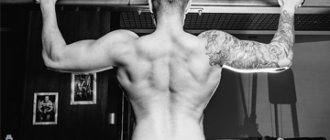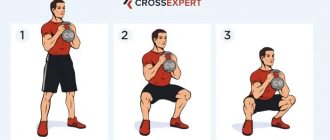- January 12, 2019
- Workouts in the gym
- Christy Larina
Relatively recently, an interesting new direction in strength sports has appeared - the Russian bench press. Every year, more and more people become not only athletes, but also spectators of this discipline. Let's take a closer look at what this sport is, what its features are, as well as the Russian bench press training program.
General description of the sport
Strength sports are quite popular in all countries of the world. There are many different directions and varieties: kettlebell lifting, weightlifting, bodybuilding, powerlifting and much more. There is also a little-known, but no less interesting and spectacular variety of strength sports in sports - this is the Russian bench press, the training program for which will be presented below.
This sport consists of one main exercise - lifting the barbell up from the chest, then back, while lying with your back on a horizontal bench. The whole point of the competition is that you need to lift a barbell of a specific weight, which depends on the individual characteristics of the athlete, the greatest number of times.
Load Cycling
Bench Press: Training Programs to Increase Strength
Four-training microcycles showed the best results. There are some points that should be taken into account when constructing any circuit in the Russian bench press:
- You should not do more than two identical presses in a four-day scheme; you should use variations: reverse grip press, bench press, close grip press, incline press at an angle of 30 degrees, dips, table push-ups, etc.
- auxiliary exercises should also be varied on different training days and make sure that they are not repeated more than twice in a microcycle.
- be sure to include strength-style exercises for the long back and abdominal muscles.
- It is imperative to include exercises for the forearm flexors in a multi-repetition mode, since in the Russian press the weight is on the hands for a long time, and it will not be possible to perform very tight bandaging of the wrists due to the long duration of the approach.
The construction of a microcycle scheme depends primarily on which of the three areas specialization is required: strength, combined or endurance (multiple repetition).
A little history
Before considering the Russian bench press training program, you should familiarize yourself a little with the history of its appearance. Let's start with the fact that this is a very young sport. The first time such competitions were held in Russia was recently in 2000. These competitions were largely entertaining and symbolic in honor of the 55th anniversary of Victory in World War II. However, currently this sport has become one of the full-fledged disciplines of powerlifting.
The Russian bench press training program has approved regulations. And also its own federation. Today this is one of the most popular types of bench press, almost like an athletic one.
Features of the IKeyMonitor application
| Advantages | Flaws |
| The application is available for download in the Google Play and Apple Store markets | The software is paid, moreover, its prices have increased. Payment must be made monthly |
| There is access not only to the camera, but also to other information on the target phone | Registration is required, otherwise you will not be able to use the application. |
| Compatible with many devices, works with Android and iOS operating systems | English language proficiency will be an advantage during registration. Otherwise, the process of obtaining an account becomes more complicated. |
Rules
Those athletes who are interested in this sport should know what Russian bench press training is, as well as the rules of the competition. During such events, to determine the winners, the so-called athleticism coefficient is derived from the ratio of the athletes’ weight to the total weight lifted. Based on this indicator, the winner of the competition is selected. At the competition, those participants who score the highest coefficient in several or one attempt, depending on the specific rules of the competition, win. Taking into account the athleticism coefficient, participants in the competition are awarded different sports categories.
Since the minimum weight of the barbell in the folk bench press training program is 55 kg, beginners can also participate in the competition. You can perform in six weight categories of the barbell depending on the weight: 55, 75, 100, 125, 150 and 200.
The competitor is given 5 minutes to complete one approach. When performing the exercise, you are allowed to rest while holding the barbell on your chest.
At the same time, athletes are prohibited from using special equipment, as well as all kinds of so-called bench shirts that allow them to lift more weight. Athletes perform in simple tights, with a bare torso, or in an ordinary T-shirt or T-shirt.
Despite the fact that the weight category of participants has a specific role in the Russian bench press, there are no weight restrictions for athletes in competitions. Due to the fact that there are not many restrictions, this sport is accessible to everyone, which is why it is gaining immense popularity today.
Please note that the Russian bench press is very democratic. It is practiced by veteran athletes, as well as disabled support workers. Therefore, it will never be too late to study Russian bench press training systems.
How to improve your bench press results and increase your performance
Powerlifting Standards
Most athletes sooner or later face the fact that their bench press numbers no longer increase, because even if you have mastered the bench press technique in all its variations, there is no guarantee that the amount of weight you lift will constantly increase. There are many factors due to which this may not happen. Let's consider the factors that prevent you from improving your results, proven by experts.
First, as trite as it may sound, you need to train regularly, because if you want to get the maximum benefit from any particular exercise, you need to do it systematically.
Secondly, it is necessary to change the grip width from time to time. From all of the above, we understand that different types of grip involve different muscle groups; accordingly, periodic changes in grip allow you to maximize the development of all kinds of pectoral muscles - this will affect the full development of the bench press technique as a whole.
Third, let's talk about nutrition.
When gaining muscle, it is important to get the required amount of calories to allow your muscles to grow and develop. On average, this is about three thousand per day
Track your calorie intake to improve your bench press results. It's also worth keeping an eye on what exactly you eat, because if you consume enough calories, you risk gaining weight and gaining fat, which you will then have to burn.
A few additional exercises to improve your bench press results:
- Stand push-ups. The essence of the exercise is the same as in push-ups, only here we rest our hands not on the floor, but on stands, which can serve as anything when it comes to doing exercises at home (thick boxes, pots, etc.). The essence of the exercise is that there is no obstacle in the form of the floor - the press can be done deeper. For maximum benefit of the exercise, your hands should be placed at the same distance as when doing a bench press. 10 repetitions are enough.
- Negative press. To perform this exercise, you need two assistants and a barbell with a weight up to 20% more than your maximum. What's the point - you very slowly lower the barbell to your chest, and assistants help you return it to its original position. It is not advisable to perform more than 3 repetitions per approach. And you don’t need many approaches. 1-2 approaches with the same number of repetitions is quite enough.
Training program
Despite the fact that the training system for this sport is in many ways similar to powerlifting training, there are still specific features. The main difference between the Russian bench press and the powerlifting press is that in the second case, the main thing is the amount of effort, and in the first, the greatest amount of work done in a specific time.
Naturally, the main exercise in the training is standard barbell manipulation. There are many different methods of training the Russian press, which a professional trainer will select individually for the athlete. Below we will consider only the main points that relate to preparation.
If we talk about the ratio of weight and number of approaches, it would be optimal to choose a system called “the devil’s dozen.” For such a Russian bench press workout, you need to select the weight in a special way. It is important that the athlete squeezes the barbell a maximum of thirteen times and a minimum of eight in one approach. Using the same scheme, you can calculate a Russian bench press training program for 75 kg.
In order for the classes to be carried out efficiently, it is not enough to perform only this exercise. Our body is a single system, which is why to improve results it is necessary to develop other muscle groups. Therefore, it is necessary to perform other exercises in addition. First of all, you should pay attention to those that are aimed at developing the triceps; a bench press with a narrow grip is well suited for this. You also need to do an exercise aimed at increasing biceps strength.
Very effective - with the so-called reverse grip, it perfectly develops the latissimus dorsi muscles. At the same time, strength is important, since at the beginning of the movement, during the Russian bench press workout, a large load is placed on this muscle.
Speaking about how many days a week to conduct classes, it is worth noting that there are different opinions on this matter. The most gentle option is to train twice a week. To increase intensity, you can train like this: two training days and two rest days.
Content
- 1 Methodology of Russian Press 1.1 Principles of training
- 1.2 Load cycling
- 1.3 Force direction (“Devil’s Dozen”)
- 1.4 About training non-major muscle groups
- 1.5 Reaching peak form
- 1.6 Nutritional considerations when preparing for competitions
- 2.1 Andrey Luchkov, founder of the Russian Bench Federation
Muscle mass
During the training period, proper nutrition is very important, and when a person gains muscle mass, diet and eating habits are important. Despite the fact that, in theory, the load of such a training process in the Russian bench press should “dry out” the muscles, practice shows the opposite. Athletes who have been involved in this sport for a long time, on the contrary, gain muscle mass.
For example, Eduard Vasilenko is a record holder in this sport, weighing more than 140 kilograms. A good increase in muscle mass is typical during the transition to working with the heaviest masses.
Risks when working with heavy weights
Pumping in bodybuilding: training programs, tips
Everything needs to be done slowly, following the technique, resorting to the help of belayers, using equipment that will protect you. But even this cannot guarantee 100% safety.
As a result of an error or accident, you can:
- pull, tear tendons;
- get an intervertebral hernia;
- injure the spine (but this is a rare case).
Muscles strengthen quickly, tendons and bones do not have time, so in pursuit of quick results you need to understand what this can lead to.
If you build your training program wisely and don’t overestimate your strength, you will be able to achieve good results and set your own records without getting injured. In the first few months of training, you shouldn’t think about it at all; you need to work on your technique, train and strengthen your muscles, and adapt to a new lifestyle. And only after three months can you introduce strength training with basic exercises.
Sports stars
In conclusion of this article, I would like to briefly talk about famous record holders who have been or are doing the Russian bench press. First of all, I would like to highlight Andrei Galtsov, who is the chairman of the technical committee of the Russian Bench Federation. He holds the title “Russian Elite” in the Russian bench press discipline. The records he set are in different categories, and some have not yet been broken.
It’s also worth mentioning Andrey Galtsov, one of the best trainers in Russia, as well as the developer of the Russian bench press training methodology. Also known is Vladimir Kravtsov, who is a record holder in the weight category up to 125 kg.
In 2012, an athlete from Ivanovo set a new world record in two weight categories at once: he pressed a barbell that weighed 75 kg 63 times, as well as a barbell that weighed 55 kg 108 times.
Rules and regulations of the Russian bench press
The official Russian Bench Press Federation establishes the rules and regulations in accordance with which competitions must be held:
- Competitions must be held on a 2.5 by 2.5 meter pedestal or other surface that must be level, stable and non-slip.
- Equipment used that meets the requirements for powerlifting or weightlifting.
- The bar must have special locks weighing 2.5 kg each.
- The racks must be at least 1 meter apart.
- The length of the bench is at least 120 cm, and the width is from 28 to 32 cm.
- The athlete can place rubber mats or discs under his feet.
- Competitors cannot apply greasy or slippery substances or designs to their backs.
- The athlete must wear sportswear that does not contain additional inclusions such as spikes. Bench shirts are prohibited.
- The use of bandages or wristbands, as well as athletic belts, is allowed.
- The use of special prostheses for disabled people is allowed.
When performing the Russian bench press, fewer demands are placed on athletes regarding sports form.
Male athletes have the right to perform with an open torso. The result is calculated using a special formula: the weight of the barbell must be multiplied by the number of repetitions performed. The resulting figure is divided by the athlete’s weight. The winner is the participant who received the most points calculated according to the formula.
Rank standards for men
The minimum weight of a barbell for competition is 35 kg, the maximum is 150 kg.
Table: bar weight 35 kg
| Discharge | bar weight (kg) | Athleticism Quotient (AC) |
| 3 youth | 35 | 12 |
| 2 youth | 35 | 14.5 |
| 1 youth | 35 | 19.5 |
| 3 sports | 35 | 26.5 |
Only boys up to 15 years old, inclusive, participate in competitions in this category.
Table: bar weight 55 kg
| Discharge | bar weight (kg) | Athleticism Quotient (AC) |
| 3 youth | 55 | 10 |
| 2 youth | 55 | 12 |
| 1 youth | 55 | 16.5 |
| 3 sports | 55 | 22 |
| 2 sports | 55 | 27.5 |
| 1 sports | 55 | 34.5 |
| KMS | 55 | 43 |
| MS | 55 | 58 |
| MSMK | 55 | 73 |
CCM, MS and elite - the athlete's weight is no more than 75 kg.
Table: bar weight 75 kg
| Discharge | bar weight (kg) | Athleticism Quotient (AC) |
| 3 youth | 75 | 8 |
| 2 youth | 75 | 10 |
| 1 youth | 75 | 13.5 |
| 3 sports | 75 | 18.5 |
| 2 sports | 75 | 24 |
| 1 sports | 75 | 30.5 |
| KMS | 75 | 37.5 |
| MS | 75 | 51 |
| MSMK | 75 | 64.5 |
Table: rod weight 100 kg
| Discharge | bar weight (kg) | Athleticism Quotient (AC) |
| 2 youth | 100 | 8 |
| 1 youth | 100 | 11 |
| 3 sports | 100 | 15 |
| 2 sports | 100 | 20 |
| 1 sports | 100 | 25 |
| KMS | 100 | 31 |
| MS | 100 | 42 |
| MSMK | 100 | 53 |
Table: bar weight 125 kg
| Discharge | bar weight (kg) | Athleticism Quotient (AC) |
| 3 sports | 125 | 12 |
| 2 sports | 125 | 15.5 |
| 1 sports | 125 | 19.5 |
| KMS | 125 | 24.5 |
| MS | 125 | 33 |
| MSMK | 125 | 41.5 |
Table: bar weight 150 kg
| Discharge | bar weight (kg) | Athleticism Quotient (AC) |
| 3 sports | 150 | 8.5 |
| 2 sports | 150 | 11.5 |
| 1 sports | 150 | 14.5 |
| KMS | 150 | 17.5 |
| MS | 150 | 24 |
| MSMK | 150 | 30.5 |
| Discharge | bar weight (kg) | Athleticism Quotient (AC) |
| Elite | 55 | 220 |
| Elite | 75 | 194.5 |
| Elite | 100 | 160 |
| Elite | 125 | 125.5 |
| Elite | 150 | 92.5 |
Table: bar weight 35 kg
| Discharge | bar weight (kg) | Athleticism Quotient (AC) |
| 2 youth | 35 | 9 |
| 1 youth | 35 | 13 |
| 3 sports | 35 | 18 |
| 2 sports | 35 | 23 |
| 1 sports | 35 | 29 |
| KMS | 35 | 36 |
| MS | 35 | 40 |
| MSMK | 55 | 45 |
Table: bar weight 45 kg
| Discharge | bar weight (kg) | Athleticism Quotient (AC) |
| 2 youth | 45 | 8 |
| 1 youth | 45 | 11 |
| 3 sports | 45 | 15 |
| 2 sports | 45 | 20 |
| 1 sports | 45 | 25 |
| KMS | 45 | 31 |
| MS | 45 | 33 |
| MSMK | 55 | 39 |
Table: bar weight 55 kg
| Discharge | bar weight (kg) | Athleticism Quotient (AC) |
| 3 sports | 55 | 12.5 |
| 2 sports | 55 | 17 |
| 1 sports | 55 | 21 |
| KMS | 55 | 26 |
| MS | 55 | 29 |
| MSMK | 55 | 32 |
Table: bar weight 75 kg
| Discharge | bar weight (kg) | Athleticism Quotient (AC) |
| 3 sports | 55 | 8 |
| 2 sports | 55 | 10.5 |
| 1 sports | 55 | 13 |
| KMS | 55 | 16 |
| MS | 55 | 18 |
| MSMK | 55 | 20 |
The right attitude.
Always try to monitor not only your body and nutrition, but also your thoughts - the right psychological attitude will help you achieve better results. If you perform the exercise sluggishly, thinking about something distracted, then the results will be just as sluggish - while bench pressing, enjoy the process, turn on energetic music. All this will increase your performance, but confused thoughts and general absent-mindedness will definitely reduce your performance (this is not speculation - there is research confirming this).
Another interesting and simple way is visualization. It helps a lot in training, because when you clearly see your goal and imagine it already achieved, the body automatically strives for the desired reality.
Features of performing working approaches
Each exercise will have a couple of preparatory sets, in which you should feel the weight and get ready for the final working set. And, of course, activate target groups, improving the brain-muscle connection. This is not just a warm-up (that is, do a regular warm-up first - approx. lane): the weight is close to the maximum working weight, the effort scores are 7 out of 10.
Then you do the main working approach. The technique will alternate, but it is necessary to bring it almost to failure (without violating the technique or cheating, of course).
To maximize hypertrophy stimulation, we will use 3 methods:
1. Set with pauses up to the maximum “two”
- Choose a weight that you can perform 4-6 reps with. First do these 4-6 repetitions,
- Rest 10-15 seconds, do another 2-3,
- Rest 10-15 seconds and then try to complete 1-2 more repetitions. This entire advanced approach is performed with one weight.
2. Maximum activation of mTor (intracellular signaling pathway)
- The peculiarity here is the pace of execution - the emphasis on the eccentric phase and stretching the muscles under load; this maximally activates the mTor signaling pathway, which causes hypertrophy.
- Lower the projectile for 5 seconds, straining the working muscle as hard as you can. In the fully extended position, pause for 2 seconds.
- Do this for 6-8 repetitions, and pause for as long as you can on the last one. This is, of course, painful, but you only do this approach once.
3. Drop set 6-8-10
- To start, take a weight that you can do 6 reps with and do them.
- Immediately reduce the load by 25-40% (depending on the exercise) - and perform another 8 repetitions.
- Unload another 25-40% - and another 10 repetitions.
Try to reduce the weight as quickly as possible (less rest) between parts of this drop set. I repeat, you only need to master one such approach.
Rate Instagram
irongenerationru
Good night ⠀ Lots of good stuff
Bring sports to the masses! Go ahead
The angle is just right ⠀ A bunch of good ones
Bring sports to the masses! Go ahead
Load more... Follow instructions on Instagram
Bench press: types and methods of execution
The traditional barbell bench press is a required exercise in most strength training programs, but there are also several variations that allow you to develop different muscle groups. Let's look at the most popular:
Dumbbell bench press.
To be honest, this exercise cannot be called a full replacement for the bench press with a barbell, but it still deserves attention. The hardest part of this exercise is keeping the dumbbells in the correct position. But it develops coordination and the ability to keep the load balanced, which helps when working with a barbell.
Bench press on an incline bench.
There is often controversy in the bodybuilding community about the “upper chest.” Should we focus on developing this so-called upper part, or is it better to train the entire thoracic region at once? What exactly is included in this “upper” part?
The upper chest usually refers to the muscles located in the collarbone area, and although they are part of the pectoralis major muscle, their structure is quite different. So different exercises have different effects on the upper chest and the chest as a whole. Of course, you cannot train exclusively the clavicular muscles, because, as already mentioned, they are part of the pectoral muscle, but you can choose exercises that will have the greatest impact on strengthening the upper chest. The incline bench press is the best.
Try different bench inclinations ranging from 30 to 45 degrees to find the one that works best for you.
One more point - during the exercise, the bar should pass near the chin and touch the body not in the nipple area, but just below the collarbone. Thus, the vertical trajectory of the rod will be achieved.
Bench press with a narrow grip.
If you decide to strengthen your triceps, then the close grip press is the best exercise you won’t find. And trained triceps will allow you to show better results in the traditional bench press. The main thing is not to overdo it with a narrow grip - if you spread your hands just a few centimeters from each other, you will achieve unpleasant consequences in the area of the shoulders and wrists. So just keep your arms a little narrower than in a standard bench press, all other recommendations are the same (feet to the floor, shoulder blades to the bench, bar arcing and touching chest).
If you feel discomfort in your wrists, just spread your arms wider. Keep them apart until the discomfort disappears.
Reverse grip press.
Grasp the bar tightly with your palms facing you - this reduces the load on your shoulders and increases the effectiveness of working the upper chest. In general, this is all you need to know about the reverse grip; all other recommendations for performing the exercise are the same as the traditional grip.
Bench press on an incline bench upside down.
This type of bench press is practiced to develop the lower part of the pectoralis major muscle, but to train this part of the chest it is better to give preference to dips.
Calculation of optimal weight
The surest way to determine your optimal weight for training is practice. Just perform the exercise with different weights and you will find out which one is right for you with your current physical fitness. But if you are used to believing formulas and tables, then you can use Brzycki’s formula (there are also Bachley and dos Remedios formulas):
1 one-time maximum = M * (36 / (37 - k)) (where M is the weight of the bar, k is the number of repetitions with this weight)
You can use the following tables to estimate what people with different levels of training are capable of:
The "no training" column shows average bench press results for those who have not performed it before, the "average" column for those who have been training in the gym for several years, and the "professional" column for competitive athletes (1% of athletes).
Instead of a conclusion: how to increase your bench press performance?
1. Always grip the bar tightly.
2. When you remove the barbell from the racks, immediately begin performing the exercise, do not pause. Move the bar in a straight line.
3. Don’t get carried away with training your pectoral muscles – two sessions a week should be enough
Training affects the entire body and central nervous system, and not just a specific muscle group; it is important to give the body a rest. Avoid Overtraining
4. Constantly improve your movement technique. If you feel that towards the end of the exercise you are no longer thinking about technique at all, it’s time to unload the bar. Do not chase the maximum weight, prepare your body gradually.
5. Visualize. Imagine how you press a certain weight, scroll through the workout in your head. In this way, you will prepare yourself and your brain for increased load.











